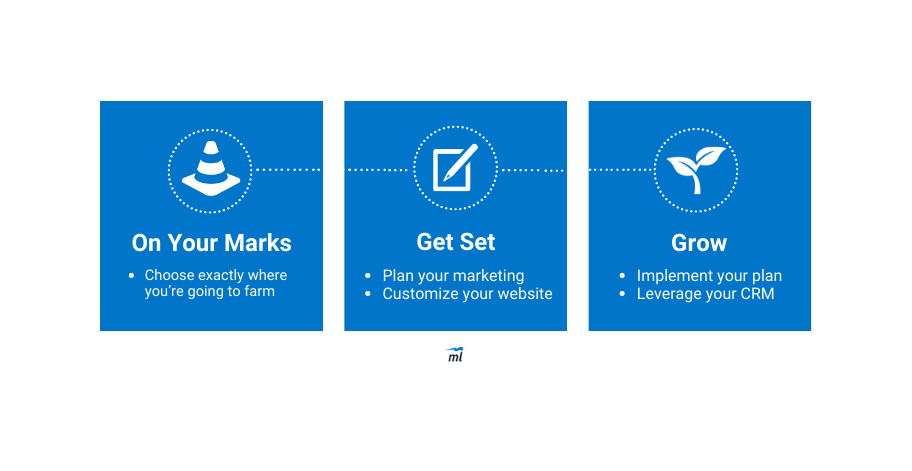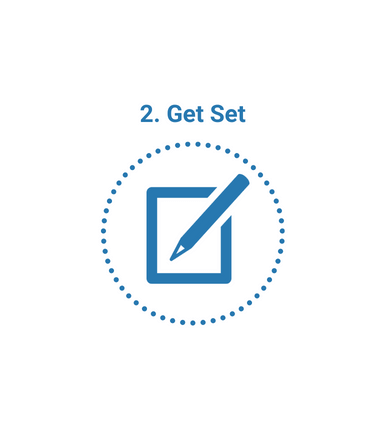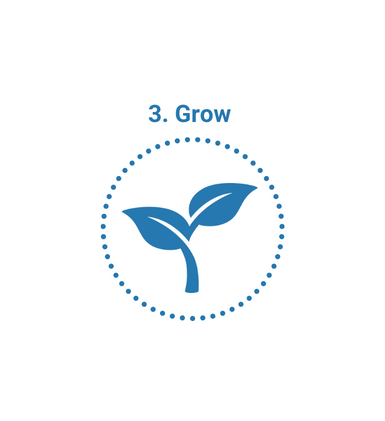What Is Real Estate Farming?
It’s a metaphor.
You are the “farmer.” The action of “farming” refers to generating leads (“planting seeds”), building relationships (“cultivating”), and turning leads into clients (“growing”).
The area where you choose to do your “farming,” of course, is your “farm.”
Put simply, real estate farming is a business strategy that involves focusing all of your marketing and lead generation efforts on one specific geographic location as a way to become the go-to agent for that area.
Farming in real estate is a common, time-honored, and often highly effective strategy. Why?
- It sets you up to become “the local real estate expert” because you’re establishing relationships, credibility, and rapport within the target neighborhood.
- It’s a great way to be highly specialized in catering to a certain audience so your marketing efforts can be clearer, more focused, and more compelling for your specific target market. (As opposed to being a generalist who attempts to be “all things to all people,” which is rarely effective.)
- When done right, agents can consistently generate new clients, which is essential to ensuring long-term success in real estate.
Ready to get started? You’re about to get a three-step beginner’s guide to farming in real estate and an overview of the tools and practical tactics you’ll need to achieve success.
The Step-By-Step Guide To Real Estate Farming

Farmers don’t just throw seeds on a plot of land somewhere and hope for the best. They make plans, mark boundaries, prepare for the seasons to come, gather all of the necessary tools, and get their hands dirty by doing the hard work that’s required to yield a bountiful harvest.
The same can be said about farming in real estate.
In this how-to guide, we’ll use “On your marks… Get set… Grow!” as our framework.
“On Your Marks” – Choose exactly where you’re going to farm.
“Get Set” – This is the prepwork stage during which you’ll craft plans and marketing strategies.
“Grow” – Get down to business by implementing your plan and tracking your progress.

Define Your Farm Area
The first step in real estate farming is to identify the boundary lines that will define your farm area. There are several criteria to consider as you determine what’s best for you and your unique situation.
Calculate Average Commission in Farm Area
Knowing the average commission you could earn in a potential farm area will help you determine whether it’s large enough, or located in the right neighborhoods, to be aligned with your income goal.
As you’re comparing neighborhoods and boundary lines, it will be helpful to use the following formula so you can get a ballpark figure for each of them.
A x B = C
A = Median listing price in the area (Need help? Start with MLS data and check out county-level and metro-level market trends.)
B = Your personal commission rate
C = The approximate commission you can expect to receive per transaction, in dollars
(If you have a commission split with a broker or team, multiply your commission per transaction total by your percentage of the split to get your split-commission per transaction total.)
Example:
A. Median listing price = $250,000
B. Commission rate = 3%
C. Commission per transaction = $7,500
Look Up Housing Turnover
You’ll need to do some MLS research to determine how many homes in the area sell each year. Look for places where there’s a healthy amount of demand and inventory.
When you combine findings from your MLS with what you know about the median listing price, you’ll be in a great position to estimate the amount of commission income the area generates on an annual basis. For example, a potential farm area with 20 real estate transactions per year and an average commission of $7,500 would net you $150,000 in total commission income – that would be a worthwhile farm area for almost every agent.
Select for Practicality
Consider choosing your own neighborhood or one that’s close to your office. Why? There are practical reasons – convenience and you save on gas and driving time, for example.
But more importantly, living within or near your farm makes it easier to familiarize yourself with the area’s community – the homes, amenities, schools, people, and lifestyle.
And familiarity with those aspects will help you know what it means to deliver value to your prospects and leads when it comes time to do that. Which, as we’ll see later, is an essential part of real estate farming.
Avoid Competition
A little bit of competition might actually be a good thing. But being the newbie who jumps into an area that’s clearly dominated by several top-performing agents may lengthen your already-long list of challenges to overcome.
If the “David and Goliath” scenario excites you, go for it. For everyone else, it’s best to look for areas where you have a better chance of staking your claim without waging a war for each and every lead.
One simple way to assess competition density is to check out Zillow profiles of local agents in the areas you’re considering to see if there are any with a huge number of recently-sold listings and very high reviews.
Find a Target Market
One of the main purposes of farming in real estate is to narrow down your target market. And that’s important because focusing on a very specific type of consumer comes with a number of benefits.
At the top of the list of benefits is your ability to position your brand and tailor your marketing in a way that speaks to the heart of your target market. And messaging like that almost always leads to higher conversion rates (i.e., more transactions).
The smaller and more concentrated your farm area is, the easier it will be to create relevant, compelling messages that appeal directly to your audience’s needs and interests.
So think small. Shoot for an area that has 500 homes or less. For you, that might include one neighborhood, one township, or maybe one (very rural) county.
Once you’ve considered all of the criteria above and you’ve zeroed in on an appropriate farm size, mark your boundary lines on a map and move on to the second step.
On your marks? Let’s get set.

Develop a Real Estate Farming Plan
Many agents will skip this second step and rush haphazardly into “the real work” of getting more leads. But to save you the trouble of learning the hard way, here’s a warning.
Without a plan, you’ll be forced to rely on luck. And luck is unreliable.
Planning not only makes your business decisions easier and your work more efficient, but it also enables you to minimize risks, chart action steps, set up dependable systems, prepare for the future, and track your progress.
As a result of effective planning, you’ll get an organized, consistent, and more profitable business. So as tempting as it may be, don’t start your real estate farming endeavor until you have a solid plan in place.
Here’s what it looks like practically to “get set” before you get to work farming in real estate.
Start With a Marketing Plan
A real estate marketing plan is an organized collection of strategies, systems, and schedules that individual agents, teams, and brokerages use to guide their marketing efforts.
Every real estate marketing plan must address the following essentials:
- Branding and brand positioning
- Setting goals and benchmarking
- Marketing (a website, email campaigns, social media, advertising, etc.)
- Advertising budgeting
- How results will be measured using data and analytics
- An understanding of current consumer expectations
- Social proof (testimonials, reviews, and case studies)
- Technology and tools
Need help getting started? Get this free downloadable marketing plan template.
Have a Website That Caters to Your Farm Area
Building up your website is one of the most important things you can do for lead generation and farming in real estate. Why? Because, unlike conventional marketing methods such as newspaper and radio ads, your website has the potential to generate leads in perpetuity – as long as you fill it with fresh, compelling content on a regular basis.
And don’t worry, you don’t have to be a web developer to create a top-notch website. You can have a fully customizable real estate website built for you.
But turning it into a lead-generating machine? That’s up to you. When you’re implementing the real estate farming strategy, your website serves three primary functions.
- It’s meant to generate new leads from your farm area.
- It’s meant to be a place where prospects, leads, and clients can find resources that will help them in the buying or selling process.
- It’s meant to establish you as the area’s trusted real estate expert.
Here’s what the best real estate agent websites include:
- A homepage that makes it immediately clear what communities you serve as part of your farm area
- MLS listings (IDX integration)
- News and information about the local community (updated weekly or biweekly)
- Neighborhood-specific market trends (and your insight and advice about that)
- Useful resources (such as a “homebuyer’s guide,” for example, or a “seller’s checklist”)
- A blog that’s SEO-friendly (Get more leads with these real estate website content best practices.)
Plan How You’ll Deliver Value
Yes, getting more leads is the end goal of farming in real estate. But that’s not really how it works – you don’t just “go get leads.”
Because the leads you want aren’t just leads or consumers. They’re people, individuals with unique situations. And, in this case, they have a specific kind of need: they need to buy or sell (or they need information about buying or selling).
So the best way to attract new leads from your farm area is to give them something of value. To be more precise, give them something related to their real estate needs that they will find valuable.
Here are five examples of the kinds of ways you can deliver value through the marketing campaigns you implement in your farm area:
- Provide neighborhood-specific market analysis and insight.
People absolutely need accurate, thoughtful real estate advice that’s specifically related to their area. They don’t need yet another reiteration of what they see in the headlines about nationwide housing market trends.
What they need is a source of reliable information that has particular relevance to their unique situation. You can be the agent who provides not just stats but useful and insightful interpretation about what the numbers mean for them.
It’s a great way to show you can provide insider information that they can’t find on Zillow.
- Offer a comparative market analysis (CMA).
A CMA benefits both buyers and sellers. By comparing their home to similar homes that either just sold or are under contract, sellers can get a better idea of what their home is currently worth. And buyers don’t want to overpay or make an offer that’s too low. A CMA helps both parties avoid these risks.
In both cases, a well-crafted CMA can provide the comfort and confidence which the prospects in your farm area are looking for. Learn how to create a CMA in four simple steps.
- Write letters (by hand).
Sure, handwritten letters can be painstaking, but the finger cramps might just be worth it. Why?
Letters are personal. Sometimes, as the adage goes, “the medium is the message.” That it’s a handwritten note can be enough to convey that you care about them as a person.
Also, the reach of handwritten letters is highly focused because they simply have less to compete with than other mediums, such as email. They stand out among all the junk mail.
As a result, not only do they provide value, but they also have a strong conversion potential. Speaking of direct mail that generates leads…
- Send postcards or distribute flyers.
The value-adding kind, not the ignorable kind. How can you make postcards and flyers valuable?
Put the focus on them and their needs, not you or why they should work with you. Share compelling information, such as the farm area’s median listing price, for example.
Or follow the advice Matt Tenczar shared in Market Leader’s webinar called “Shift Happens: How To Thrive in Any Market”: Keep your message short and simple, and use a QR code so the recipient can go straight to your website from their doorstep.
- Share reviews and testimonials.
While this might seem self-centered, it’s actually a great way to add value. Here’s why:
It boosts their confidence in your expertise and shows why they can trust you. And it eases any concerns they might have about the buying or selling process.
Reviews and testimonials are especially valuable if they come from neighbors or people they might run into at the local grocery store. This is often referred to as “social proof,” and it’s an essential part of any serious marketing campaign.

Implement Your Real Estate Farming Plan
You’ve marked out your farm area. You’ve set yourself up with a solid plan. Now it’s time to grow! As you’re implementing your real estate farming plan, it’s a good idea to have systems in place to ensure success along the way.
Track Your Progress
Progress monitoring is an important part of farming in real estate for the following reasons:
- It’s a way of holding yourself accountable to the goals you set.
- It provides you with the feedback you need to make strategic adjustments.
- It enables you to create new benchmarks for future goals.
- It takes the guesswork out of your professional self-reflection.
- It’s the most efficient way to spot what’s working well and what needs improvement.
- It helps you prioritize and keeps you focused on what matters most.
Having a simple progress-tracking system in place will enable you to conduct regular check-ups on your marketing plan and key performance indicators like number of leads and sales.
If you’re looking for help in this area, check out this free 2023 business planning template.
Use a Real Estate CRM
There are many tools real estate agents need to maximize their gross commission income. At the top of the list of “must-haves” is a CRM – customer relationship management software.
Strong lead generation is crucial to your success, but it won’t significantly impact your commission income unless you have a system in place that allows you not only to get more leads but to develop a relationship with them so you can convert them into clients.
That’s what the best real estate CRM can do for you, and that’s why it’s something you can’t do without. (Need help finding the right one for you? Check out this CRM shopping guide.)
Master Real Estate Farming With This Single System
Market Leader Pro gives real estate agents everything they need to generate leads and turn them into lifelong clients. This single solution includes:
✅ A customizable website that can be tailored to fit the need of your real estate farm area
✅ A robust, fully integrated CRM so you can maintain strong relationships with your contacts
✅ Marketing automation tools like drip campaigns, which include a full suite of professionally designed email and print mail templates
FAQ About Farming in Real Estate
1. “How long does it take to see results from farming in real estate?”
Unfortunately, the only truthful answer to this question is: it depends. There are too many variables involved (e.g., time invested, finances invested, competition, current housing market conditions, etc.) to offer a definite timeline.
Like just about everything else in our industry, farming in real estate is about building trust and relationships. That can take time, and it’s rarely predictable. Agents who consistently follow up with leads, send direct mail, and engage with the community tend to see long-term success.
To give you a ballpark idea, it often takes 6 months to a year to see significant results from farming in real estate. That said, it’s not exactly a “get rich quick” scheme. It’s more of a long-term investment that eventually pays off after implementing a variety of consistent and effective marketing strategies.
2. “What is the biggest mistake agents make when farming in real estate?”
One of the biggest mistakes agents make when farming in real estate is not being consistent with their efforts. Farming a neighborhood or area requires ongoing, regular engagement and marketing to build name recognition and trust over time. Many agents start with enthusiasm but fail to maintain a strong presence in their community long enough for it to yield results. Other common mistakes include:
- Targeting too large of an area: Stretching efforts too thin can make it harder to build strong relationships and visibility in one focused market.
- Neglecting personalized follow-up: Agents often focus on sending out marketing materials but fail to follow up personally with leads or past clients in their farm area.
- Using generic messaging: Instead of tailoring communication to the local community, agents might send out broad, impersonal content that doesn’t resonate with the specific market.
3. “Can I farm in multiple areas at once?”
Yes, there’s nothing wrong with expanding your reach! But keep in mind that the whole point of farming in real estate is to focus all of your marketing and lead generation efforts on one specific geographic location as a way to become the go-to agent for that area.
Trying to reach everyone everywhere is rarely worth the significant investment of time, money, and resources it demands.
If you’re just starting out and your budget is somewhat limited, it’s best to focus on one area. As your business (and budget) grows and you’re certain you’ve established yourself in your initial farm, you might want to consider expanding to other areas.
4. “What is demographic farming in real estate?”
Demographic farming in real estate is a targeted marketing strategy where agents focus their efforts on specific groups of people who share common characteristics, such as age, income level, occupation, or lifestyle, rather than on a geographical area (as in traditional geographic farming).
This approach allows agents to tailor their marketing messages and services to meet the needs, preferences, and interests of a particular demographic, which can increase the chances of success in converting leads into clients.
For example, an agent focusing on retirees might market homes with single-story layouts, easy access to medical facilities, or quiet neighborhoods. While an agent who’s targeting young professionals might highlight proximity to nightlife, restaurants, or public transit.
Like geographic farming, demographic farming in real estate is one way agents can build deeper connections with a very specific audience by understanding and addressing their specific needs—thereby increasing the likelihood that they can turn more consumers into leads and more leads into clients.
5. “What do I do if my farming strategy is ineffective?”
There’s no one-size-fits-all answer to this question because too many variables are at play. Figuring out what’s not working can be a challenge, but don’t worry—there are ways to troubleshoot. To help guide you, here are a few key questions to consider that might shed light on what adjustments can improve your results:
- Are you consistent in your efforts? Farming takes time and regular engagement. Sporadic or short-term efforts may not yield the results you’re hoping for.
- Is your farm area too large or too small? Stretching yourself too thin over a large area can dilute your impact, while a farm that’s too small may not provide enough opportunities.
- Are you providing value? People respond to value. Are you offering useful market insights, tips, or resources, or are your messages just promotional?
- How are you engaging with leads? Sending out materials is only half the battle. Are you following up personally to build relationships and trust?
- Are you targeting the right audience? Do the people in your farm area fit your ideal client profile? Consider whether another demographic or neighborhood might be a better fit.
- What does your competition look like? Take a look at other agents in the area. If it’s oversaturated, it might be harder to break through. Are you offering something unique?
By asking yourself these questions, you might uncover key areas where small tweaks could lead to better results.
 800.978.5174
800.978.5174
